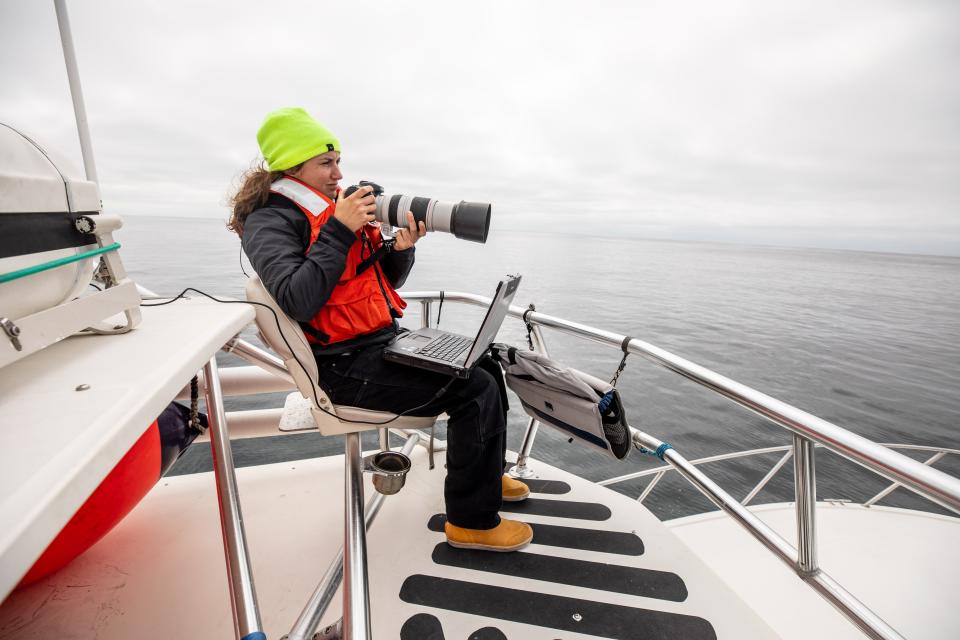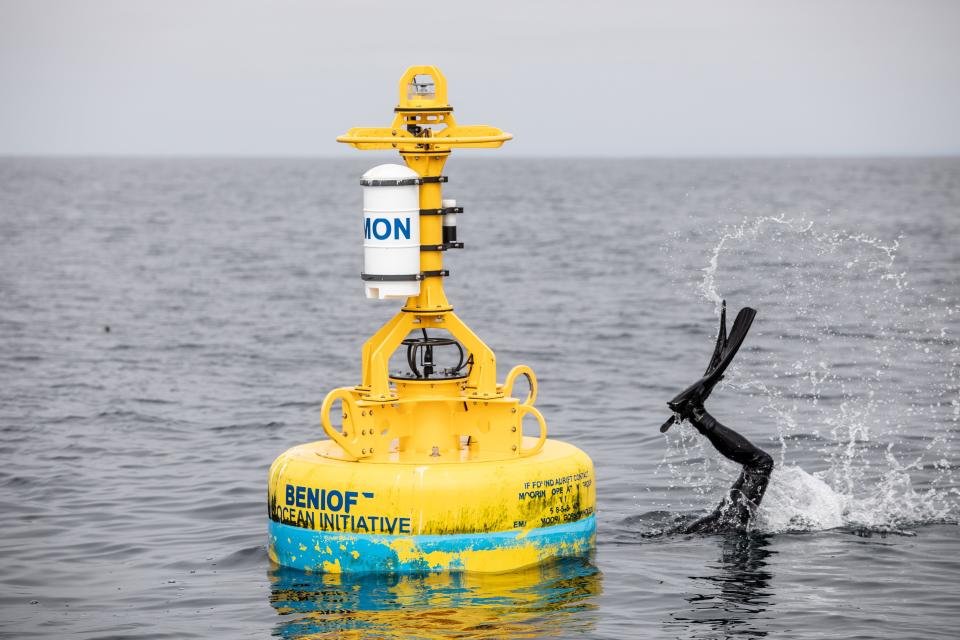Speed limits in the ocean? Massive ships are killing endangered whales each year.
OFF THE FARALLON ISLANDS, Calif. – Twenty-eight miles off San Francisco Bay, the sea is alive with whales. Spout after spout shoot from the water as more than two dozen humpbacks feast on glittering schools of anchovies.
From the prow of a small boat, Bekah Lane, program coordinator for the Marine Mammal Center in Sausalito, California, scrambles to track them all.
"There's a group of five over there, and another three over there, and at least four moms with calves," she said, binoculars scanning back and forth over the water. "We're just surrounded by whales here."
Unfortunately, the abundant fish that draw humpbacks here mean these whales are effectively having a picnic on a freeway – and they don't know they're in danger. These rich feeding grounds are smack in the middle of the path to the fourth-busiest ports on the West Coast. Ships the size of the Empire State Building power through daily to reach docks in Oakland and San Francisco.

More than 80 whales are struck and killed each year in West Coast shipping lanes, the roadkill of robust international trade. So far, 2018, 2019 and 2021 have been the worst years on record for whale-ship collisions.
Lane and other scientists are part of a recently launched tool called Whale Safe that's working to give the mammals a fighting chance by getting ships to slow down when whales are present, just as cars slow down in school zones.
Attired in a wetsuit, marine biologist Douglas McCauley sits on the deck below Lane, his eyes picking out mothers and their calves in the roiling waters. He helped construct the system. Now he's about to jump in the water to do some adjustments to the acoustic buoy that's busy listening for whales even when they're deep underwater, invisible to the humans above.
As intelligent as they are, he explained, whales haven't yet learned how to avoid ships in part because so many interactions result in death.
In late August, a humpback mother with a calf that had been tracked by whale watchers for years had her skull knocked off her spine in a ship strike. She was known as Fran, and her body washed ashore near San Francisco. Researchers are still looking for her calf.
MORE: Fran, California's 'most popular' whale, likely killed by ship collision
Whale Safe was first launched off the Southern California coast two years ago. In September, San Francisco was added, which scientists hope "can help protect whales like Fran all along the California coast," McCauley said.
Eventually, they want to add Seattle and Vancouver, British Columbia, to protect these enormous creatures as they travel the West Coast between their winter feeding grounds near Alaska and their breeding grounds near Mexico.
Telling ships how 'whaley' it is
Working with scientists at universities and research groups around the world, Whale Safe hinges on an acoustical buoy that listens for whales.
The bright yellow beacon, designed and built by Woods Hole Oceanographic Institution in Massachusetts, doesn't look like much in the water. But it's a half-million-dollar piece of equipment that carries a high-tech hydrophone that constantly listens for whale songs, translating them into a count of whales and species using an onboard computer.
Taking a deep breath, McCauley falls backward into the 55-degree water, then dives to the bottom of the buoy.

The system uses information from the buoy, sightings logged by trained researchers such as Lane, and a predictive model of blue whale habitat preferences and oceanographic data.
Combined and posted online, these give passing ships an hourly "whale presence" rating of low, medium, high or very high. In the past month 126 humpbacks have been sighted and the buoy has heard blue and fin whales in the vicinity, giving most days a "very high" rating.
Whale Safe can't give exact locations for individual whales, but captains don't need that, McCauley said.
"What we're giving the shipping industry is a risk index," McCauley said. "We're telling them how 'whaley' it is on any given day and how important it is that they slow down then."
That, at least, gives them a chance.
Even a 330,000-pound blue whale is no match for a 300-ton ship.
“It’s not like a deer and a car. It’s more like a deer and a skyscraper,” McCauley said.
OFF FLORIDA COAST: NOAA wants boats to slow for right whales
Asking nicely hasn't helped whales
For years, the National Oceanic and Atmospheric Administration has asked the enormous ships that ply the shipping lanes heading into San Francisco Bay to voluntarily cut their speed during whale migration season.
Some do, but many don't.
The scientists behind Whale Safe hope that by giving ships – and the companies that run them – near-real-time updates on when whales are present, they'll be more inclined to slow down.
"It can also be made available directly to the captain of the ship; they can get it on their phone as well," said Kathi George, director of field operations and response at the Marine Mammal Center.
More: Follow USA TODAY's climate change coverage
Whale Safe also assigns a letter grade based on safe speed to companies running large ships in the area. An "A" means whale-saving speeds. An "F" means too many ships barreling through.
Most people have never heard of the shipping companies, but they carry the things Americans buy every day, McCauley said.
"I don't think people realize there's an opportunity for saving whales every time they go into a store," he said. By pushing retailers to use only shippers that are whale-safe, "consumers can have some leverage."
The Whale Safe tool makes report cards for companies running ships of more than 300 tons.
Together with other efforts by NOAA, the Southern California Whale Safe program is seeing success. Compliance with the voluntary speed reductions has increased each year, from 47% in 2019 to 62% this year, said Callie Steffen, Whale Safe project scientist at the University of California, Santa Barbara.
That system, together with other initiatives – such as Protecting Blue Whales and Blue Skies, a program that incentivizes companies to slow their ships – has helped make a difference, said Sean Hastings, policy and information officer at NOAA's Channel Islands National Marine Sanctuary off the Santa Barbara coast.
NOAA scientists calculate that if 90% of the large ships cooperated with the Vessel Speed Reduction Program, the risk of lethal ship strikes would be reduced by as much as 30%.
Preliminary figures show that this year the cooperation rate in Southern California is just shy of 70%, Hastings said.
It's not enough. "We really do need 100% cooperation," he said.
Whales and ships sharing the sea
Lacking mandates, Whale Safe hopes information and public shaming will encourage companies to slow down.
This year, the world's largest shipper, MSC, got an A. It has incorporated the data stream directly into its ships' navigation software and is setting the standard for others, Hastings said.
"They're slowing their ships down over 90% of the time," he said. "It's a beautiful thing."
Other companies say they can't.
Matson, a Honolulu-based company that mainly ships to Alaska, Hawaii and Guam, said it's not able to slow down because of the urgency of its cargo. It slows its ships "to the greatest extent possible" but can't always because "when a ship is late, our communities see empty shelves," said spokesman Keoni Wagner.
Whale Safe data for Matson ships entering or exiting Los Angeles and Long Beach ports found that 57.5% of Matson ships traveled 12 to 15 knots in the go-slow area.
A NOAA study showed that because slower speeds result in fuel efficiency, slowing to 10 knots in shipping lanes during the months whales are present in Southern California would result in only a 2% increase in total costs for shippers.
Conservationists have also strongly advocated for shifting sea lanes slightly to avoid areas where whales tend to congregate. The NOAA study found this decreased ship transit times, so doing so plus slowing in ship lanes actually lowered costs by 1.6%.
The problem is only going to get worse, said John Calambokidis, a cetacean expert with Cascadia Research, a nonprofit organization in in Olympia, Washington, that focuses on whale research. Whale populations are recovering just as international shipping is increasing. Today there are more whales and more large ships in the oceans, and those ships are bigger and moving faster than ever before.
Though Whale Safe isn't a total solution, it is a valuable piece of the puzzle, said Cotton Rockwood, a senior marine ecologist with Point Blue Conservation Science, a nonprofit that contracts with NOAA to study whale populations.
Companies really do want to end ship strikes. "Nobody wants to kill a whale. It's heartbreaking when it happens," he said.
Without mandatory speed restrictions, it's hard to get industry buy-in because voluntary slowdowns put companies doing the right thing at a disadvantage. "It's got to be a level playing field," he said.
That's part of Whale Safe's secret weapon. By making speeds public, consumers can pressure businesses they buy from to pressure shippers.
At the Channel Islands National Marine Sanctuary office, Hastings thinks most Americans would be glad to factor the value of whale's life into the timing of their next purchase.
"I'm pretty confident," he said, "that you and I could wait an extra minute for our iPhone to hit the shelf."
Elizabeth Weise covers climate and environment issues for USA TODAY. She can be reached at eweise@usatoday.com.
EARLIER THIS YEAR: Dead fish are piling up on San Francisco Bay Area shores. A toxic algae bloom is likely cause.
This article originally appeared on USA TODAY: Pacific Ocean speed limits? Ships kill endangered whales each year

